How to visit the Nubian pyramids in Sudan
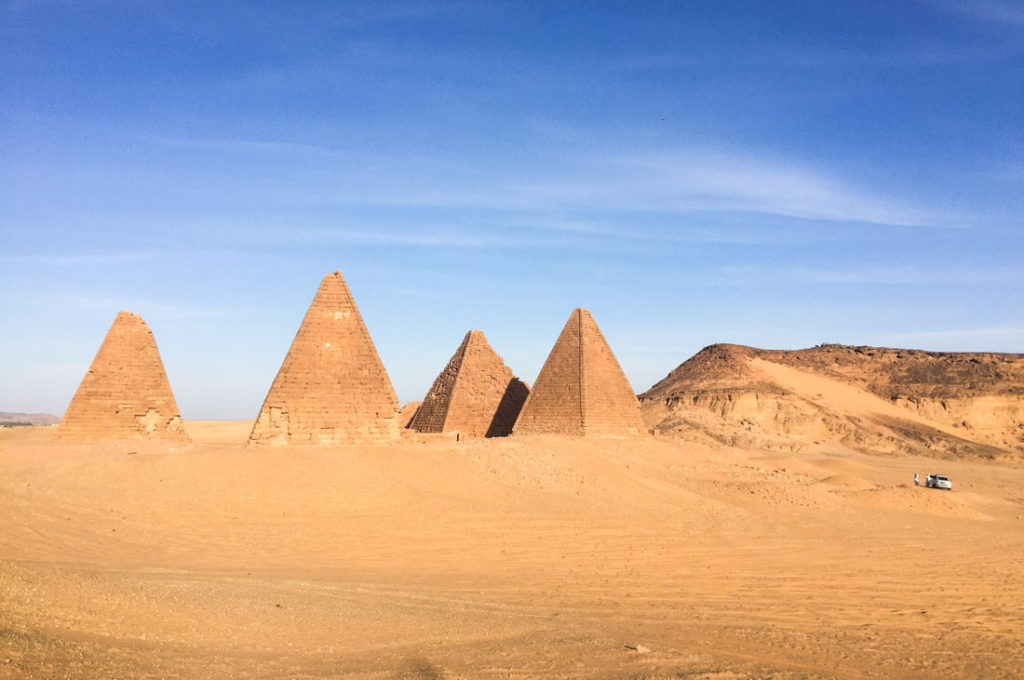
Sudan is home to several archaeological sites, including the most off the beaten track pyramids you will ever visit. This guide is to help you know where to find and how to visit the pyramids in Sudan each one of them
There are two main reasons why travelers go to Sudan: because of the people and because of the pyramids.
Wait… pyramids? Yes! I was also quite surprised but it turns out that, in Sudan, there is a total of 255 pyramids.
That’s pretty impressive, right? Yes, it is. These pyramids, which were built around 2,500 ago, served as tombs for the Nubian kings and queens of Napata and Meroë and, even though all this region had a strong Ancient Egyptian influence, they are quite different from the ones in Egypt, as they are narrower and taller.
Visiting the pyramids in Sudan is definitely one of the highlights, not only because of their historical background but also, because they are so remote and very few people visit Sudan, so nowhere else in the world will you have as many pyramids just to yourself.
For practical information, including a 2-week itinerary, read my travel guide to Sudan

How to visit the Nubian pyramids in Sudan
Index:
Table of Contents
Remember to get travel insurance for Sudan
IATI Insurance is one of the very few that covers travel in Sudan + COVID-19
5% discount if purchasing via this link
The pyramids in Sudan: A historical introduction
Nubia, located in the north of Sudan, was once home to three Kushite Kingdoms: Kerma (2600-1520 BC), Napata (1000-300 BC) and Meroë (300 BC-300 AD). The Nubian pyramids were built during the Napata and Meroë Kingdoms, two kingdoms that were strongly influenced by the Ancient Egyptian culture, as in 751 B.C., during the Napata Kingdom, one Kushite king named Piankhi overthrew the 24th Egyptian Dynasty, merged the whole Nile Valley and became the first Pharaoh of the 25th Dynasty. The Napatan domination of Egypt ended in 656 B.C.
Visiting the Nubian pyramids of Sudan – Things you should know
Tourism is in a real emerging stage – Which means that tourism transportation doesn’t exist.
Bring suitable clothes – The pyramids are located in the middle of the desert and Sudan is one of the hottest countries on Earth. Even during the cooler months of December and January, the heat is unbearable
Bring water and food – Around the pyramids, there are no shops where to buy water or food.
Always pay in local currency – In some sites, they ask you to purchase an expensive entrance ticket in USD. Just tell them that you don’t have USD, so they will tell you the price in SDG, which will be around 30% of the original price.
Responsible tourism – Sometimes, you may see locals climbing the pyramids and painting their walls. Don’t worry. Nobody has ever taught them that this is very wrong. Just don’t imitate them.
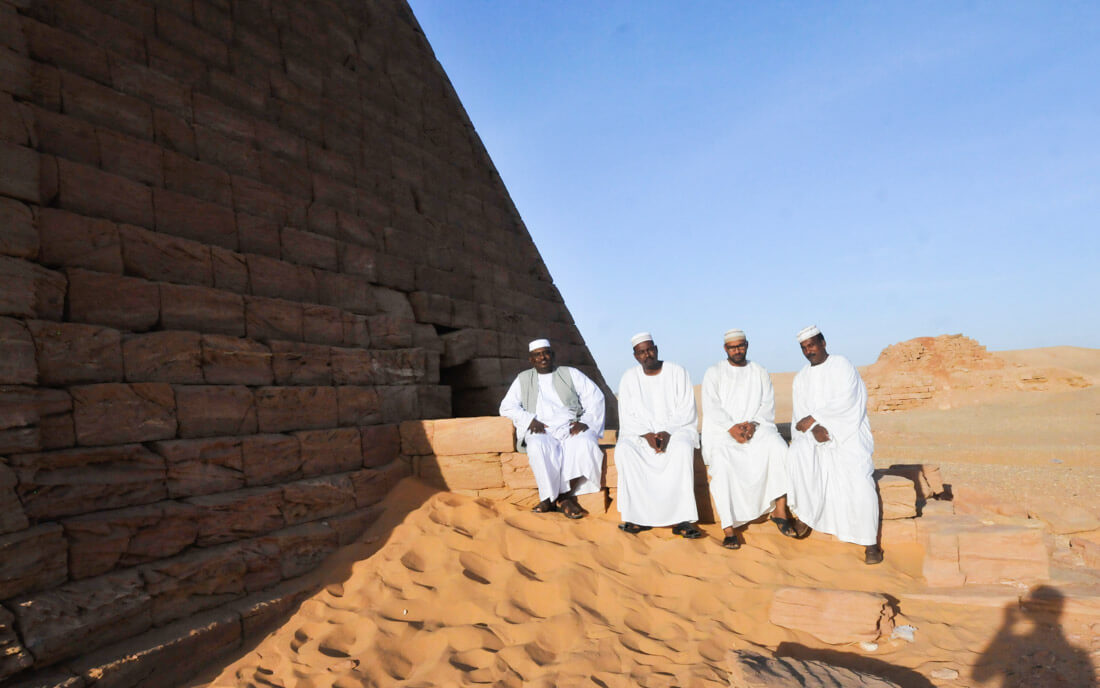
Visiting the Sudan pyramids – Where are they located?
Most of the Nubian pyramids are found in two main areas, containing four main sites:
Around Karima (Kingdom of Napata sites)
Jebel Barkal – In my opinion, this is the best site for being surrounded by the most beautiful landscape
Nuri – The pyramids from this site are in a deplorable state but that’s the beauty of them
Al-Kurru – Almost completely destroyed, as the locals took the stones to build their houses
Around Shendi (Kingdom of Meroë site)
Meroë – The most visited site in Sudan and the only one which is slowly being restored
Visiting the Nubian pyramids of Sudan around Karima
Around Karima, there are three different archaeological sites, so you can stay in Karima for a couple of days and use it as a base to explore the area. Karima is a small town where you can find a few hotels and guest houses.
Where to stay? – I stayed in Al-Nassr, a local hotel frequented by Sudanese. In 2018, they are charging 150SDG ($6.20) for a private room with private bathroom. Alternatively, there’s a fancy guest house called Nubian Rest House, which offers semi-luxury rooms for around $100.
Update 2018: This company is crazy and, apparently, in 2018, they are charging around $200 for just one night!
This is the location of both hotels:
Jebel Barkal
Jebel Barkal is a small mountain which once served as a landmark for the traders, at the point where it was easier to cross the Nile River. During those times, it was also believed to be home to the god Amun, as the sharp point of the rock has the shape of a cobra with a crown, the symbol of the king.
Today, together with the city of Napata located at its feet, UNESCO declared it a World Heritage site. Jebel Barkal contains a royal cemetery that that has around nine Nubian pyramids, in relatively good condition, built between the third and first century B.C.
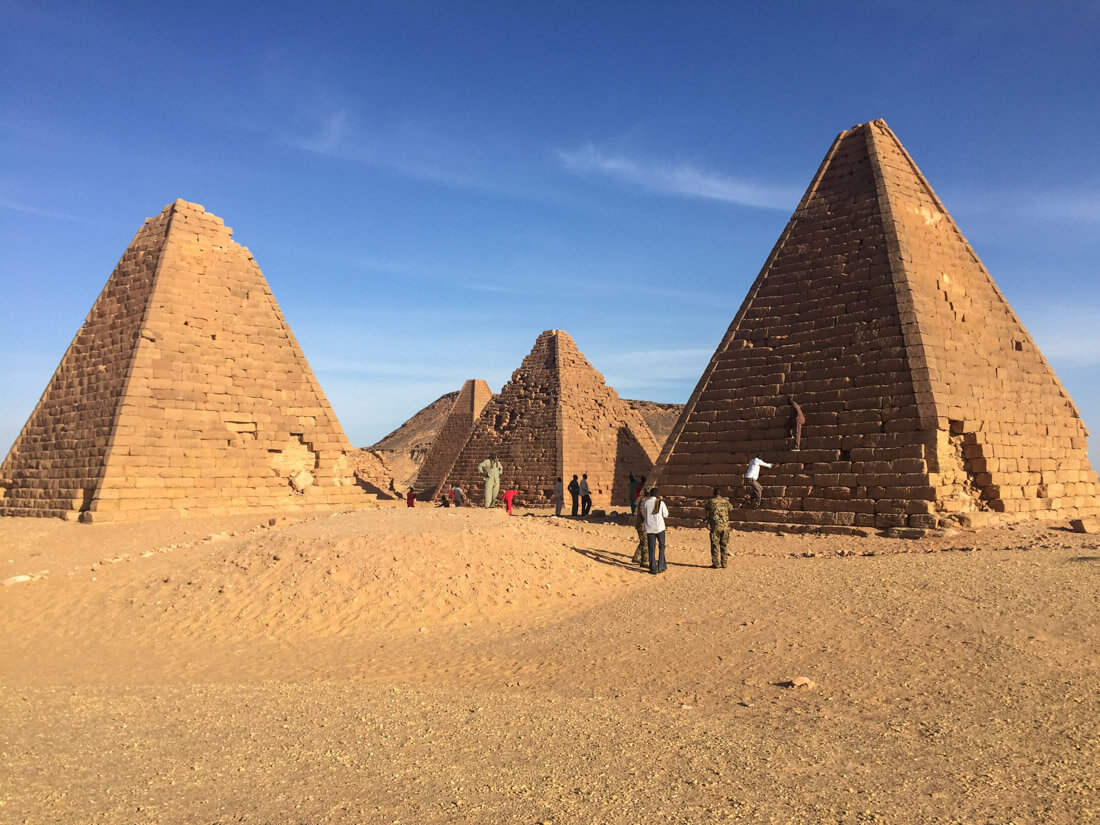
The mountain of Barkal (Jebel means mountain) is a favorite place for young Sudanese to see the sunset. Every day, dozens of them climb it to enjoy the magnificent views over the Nile. If you want to make the best of your visit, go there around 4 pm and allow yourself one hour to visit the pyramids. After that, go up the mountain to enjoy the sunset with the Sudanese.
Price – Visiting the pyramids is free but there’s an entrance ticket for the Temple of Mut, which has some interesting paintings. Officially, it costs $10, but give them 50SDG ($2.10) and you’ll be fine.
How to get there – It’s on a walking distance, just three kilometers from al-Nassr Hotel.
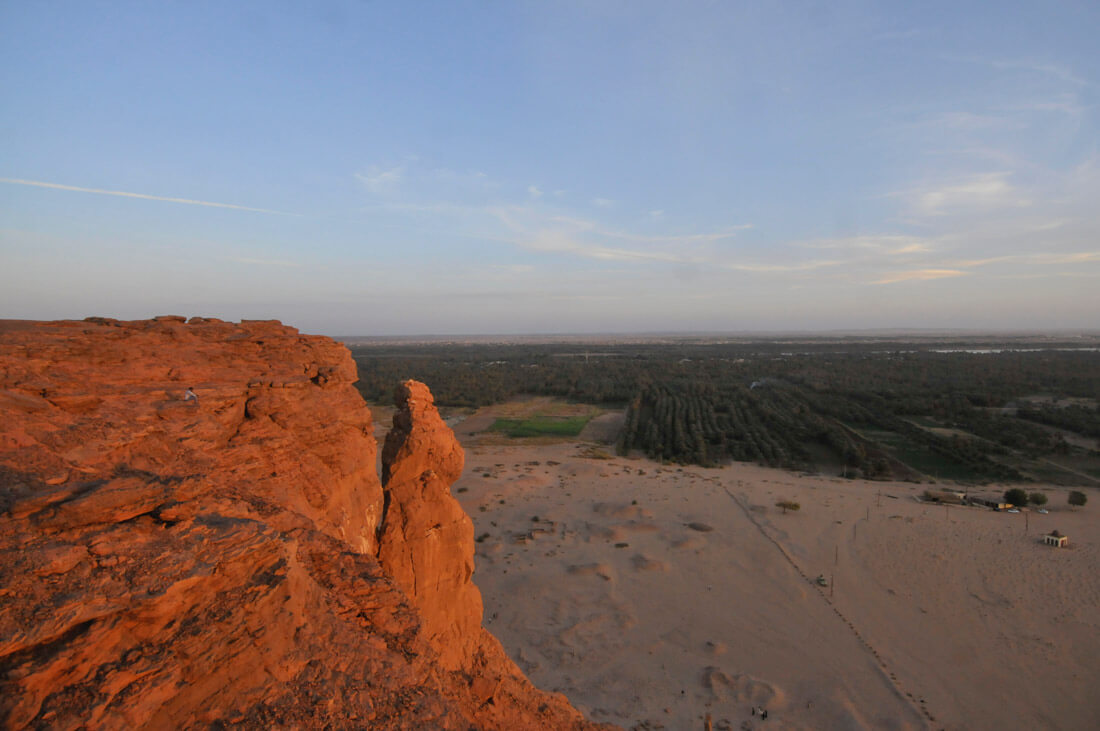
Nuri
Also belonging to the ancient city of Napata, in Nuri, there are around 60 pyramids but, unfortunately, most of them are in a very deplorable condition, buried under a sea of sand. Nevertheless, it’s interesting to see all of those deteriorating buildings in the middle of the desert. Pretty often, you see locals trying to climb them, including Taharka’s pyramid, the highest Nubian pyramid. The guards don’t even care about it.
Next to the ruins, there’s a small village where you could take a break and hang out with the local families, who will invite you to have some tea.
Price – Price is around $10, which is extremely excessive, given the pyramid’s condition. However, like in most sites, you may be able to negotiate it down and pay in local currency, which will, definitely, be cheaper.
How to get there – Since Nuri is located on the other site of the Nile, you need to take a local bus from Karima to Merowe. In Merowe, take another local bus to Nuri. Price: 5SDG.

El-Kurru
Built from 795 B.C. to 315 B.C., the pyramids of El-Kurru are so deteriorated that it took me a while to figure out that I was already at the archaeological site. Many of the pyramids are just empty holes or have entrances which have been buried under the sand. The locals used their stones to build their houses. There’s not much to see in El-Kurru, besides the tomb of the King Tanwetamani, which contains very well-preserved paintings.
The only issue is that the tomb is locked so you must ask in the village for the guy who has the key. I went there around 5 pm and didn’t find the guy, so couldn’t get in. I suggest you go there earlier.
Price – The guy charges around 60SDG ($3.80).
How to get there – From Karima, take a mini-bus to El-Kurru. The bus will leave you on the road, so you have to take the left and walk one kilometer until you find the site.
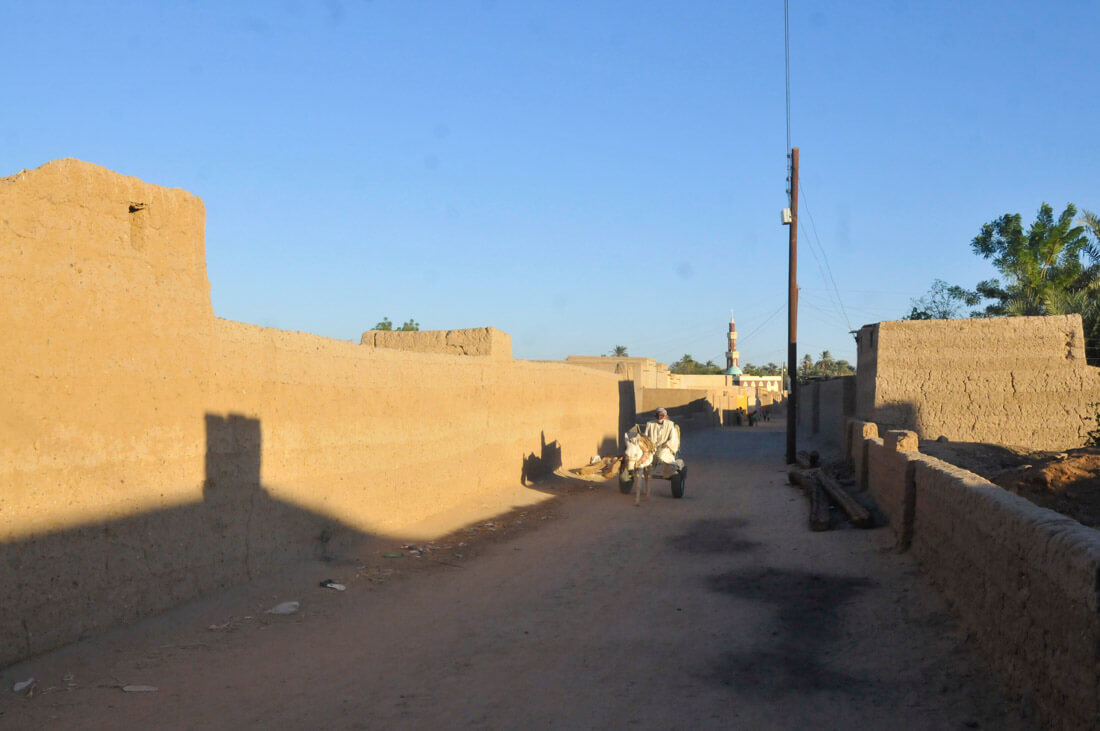
Visiting the Nubian pyramids of Sudan around Shendi
The pyramids of Meroë are actually 50km from Shendi but this is the biggest town close to Meroë.
Where to stay – You have 4 options. First, you could stay in Khartoum and come to Meroë on a day trip, which is what most travelers do. Second, you could stay in one of the few budget hotels in Shendi. Check my Sudan travel guide for more information. Third, there are several resting places along the road between Atbara and Shendi, where the truck drivers spend the night for as little as 5SDG ($0.30). Basically, they have a bunch of deck chairs placed outside. I stayed here 🙂 And fourth, you may stay at the Meroe Tented Camp, which is a desert camp with relatively luxury tents that cost 1,000SDG a night ($42).
Meroë
The royal cemetery of Meroë is composed of 100 narrow pyramids spread across a vast desert of orange sand dunes. Most of them are quite well-preserved and, by the end of 2016, the site was still under restoration. Meroë is, by far, the most impressive site in Sudan, hence the most visited one. This is the only proper tourist attraction in the country, as the site is surrounded by a fence and there are Sudanese people who can’t wait to sell you souvenirs. Nevertheless, you’ll have the place almost to yourself. When I visited it, I just met one elderly couple from the UK.
Price – Some people pay 50SDG ($2.10) while other pay 200SDG ($8.30). It depends on his negotiation skills as well as his mood. The official price is ridiculous, and they ask you to pay $30. But, once again, just say you don’t have USD. Update 2018: Price is not as much negotiable anymore and you are asked to pay 300SDG or 20USD. However, if you have a student ID, you may be able to reduce the price up to 50%.
How to get there – You can visit Meroë as a day trip from Khartoum. Moreover, you can reach it by local bus from Shendi or Atbara. The pyramids can be seen from the main road. You can’t miss them.
More information for visiting Nubian Pyramids
📢 In my Travel Resources Page you can find the list of all the sites and services I use to book hotels, tours, travel insurance and more.
Don’t forget to check our travel guide to Sudan.
As well as all our Sudan articles:
This is what you needed to know regarding visiting the Pyramids in Sudan. If you have any updated information, especially regarding prices, kindly let us know in the comments!
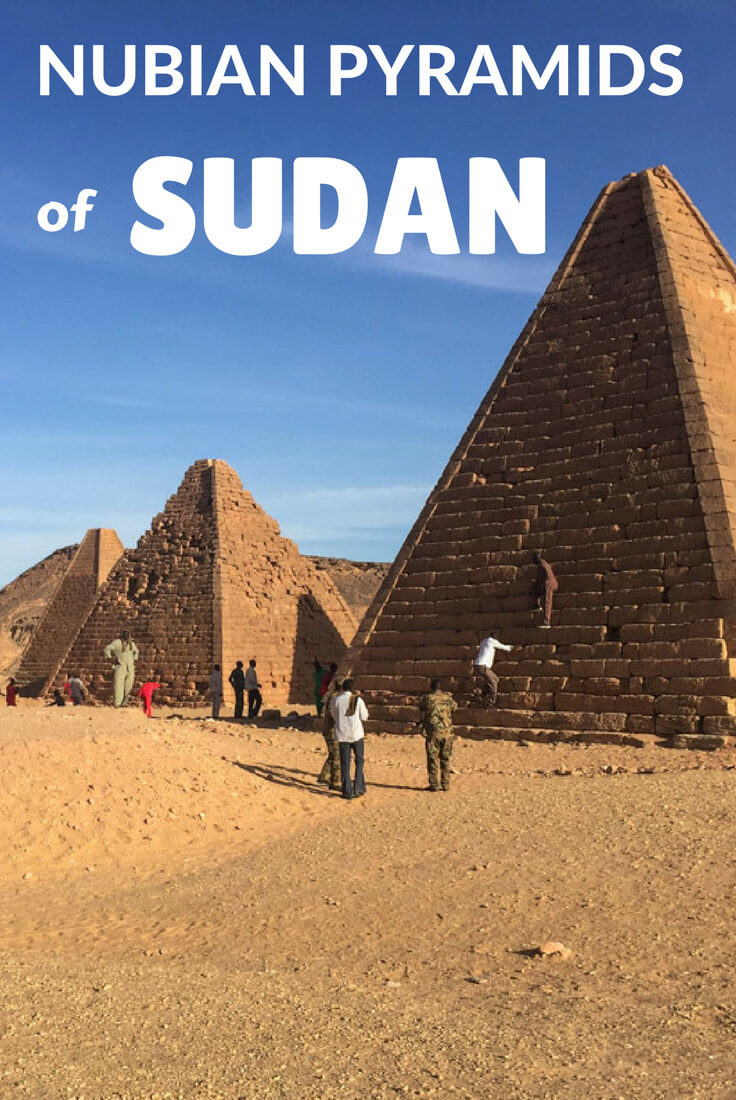
21 comments
Whoa. I had no idea there were ANY pyramids in Sudan. It is definitely impressive that there are so many and it would be a great experience to visit them without as many tourists as pyramids in other places.
Hello Sky, yeah it’s pretty impressive to walk around all those pyramids without the presence of a single tourist. The only thing is that many sites are just abandoned, like if the government didn’t care about them, which is what actually happens. Anyways. Thanks for your comment!
I hitched back to Atbara from Meroe no problem. You could be waiting a long time to pick up a passing bus with seats spare so give it a go
Hey Graham, thanks for your comment. Actually, I also hitchhiked from Atbara to Meroe! I took a bus from Karima to Atbara but the bus didn’t leave me in the city but on the road. Then I wanted to take a bus and you are absolutely right. The buses were full and it was quicker and easier to hitch! I think I should put this on the guide as well.
Nice post! We spent two weeks backpacking in Northern Sudan last year and visited all of the above sites. To visit Nuri, we took the ferry from Karima to the other side of the Nile and walked/ hitchhiked from there, what was very pleasant.
I didn’t know it was possible to take a ferry. Thanks for the tip, I will include it 🙂
Hey!
Thank you for writing about your trip to Sudan – it’s quite hard to find recent info on travelling in the country.
Do you remember how often some of those busses are running? I wouldn’t imagine that they’re running that often.
Also, how did you get from that trucker hostel between Shendi and Meröe? Did you catch a bus or hitchhiked?
Hey Per,
thanks for your kind message.
Buses are very frequent, so you shouldn’t be worried about that
And about the trucker hostel… It was just on the road, really close to mweroë. I just stopped there. there are also plenty of road hostels all over that road
Hello,
Thanks a lot for your information. I am planning to go to Sudan next year may be in March. Is that feasible to get around to the pyramid sites by one’s own e.g. take a bus between town and sites. I would prefer to travel by myself not with tour.
Thanks,
Sirisak
Hi Sirisak. Yes, it’s totally doable. I did it myself. You can check my itinerary (plus how to get into places) here: https://againstthecompass.com/en/sudan-travel-guide-backpacking/
Any tips for a female solo traveler? Is it feasible to stay in one of those “trucker hostel”?
Hi, next week I am publishing an interview/article about solo female travel in Sudan. Stay tuned. Cheers,
Hello, I just published this article about solo female travel in Sudan: https://againstthecompass.com/en/visit-sudan-female-traveler/ Let me know if you have any questions 🙂
Thanks a lot for the information.It is really nice place to visit.
Hey guys anybody could give me location for these bus stop accomodation in between atbara and shendi! Or are they easy to find?? Also is it walking distance from the pyramids? Cheers Tristan
I’m going to Khartoum and Meroe and your blog is the best advice that I have found so far! Thank you.
thank you 🙂
Egypt is part of Africa and if you do the research you8find that Nubia is the birthplace of Egypt… FACTS
@JoJo Dancer Very true. This was a good article but it does has some incorrect information.
FACTS – you’re boring
will you be leading any trips to the Sudan around the end of 2022?
best
Chuck Schagrin